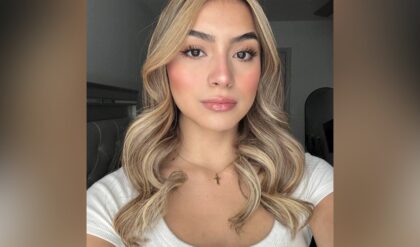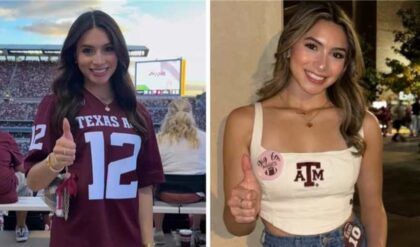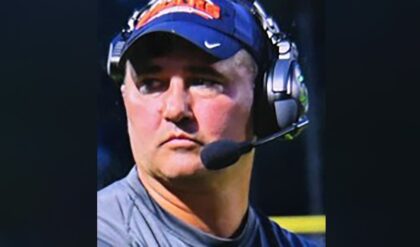After an awards season that saw Lily Gladstone scoop up a Golden Globe and a SAG Award for her astonishing work as Mollie Burkhart in Martin Scorsese’s Killers of the Flower Moon, the actor has moved swiftly on to her next project: Hulu’s limited series Under the Bridge, based on the best-selling true-crime book by Rebecca Godfrey.
%20.jpg)
In it, Gladstone plays Cam Bentland, an Indigenous policewoman determined to solve the missing-person turned homicide case of Reena Virk, an Indo-Canadian 14-year-old girl, in the late 1990s. Badly bullied at her school in ultra-white Victoria, Reena falls in with a local group of teens who style themselves the “Crip Mafia Cartel” before she’s discovered dead.
Initially, the story gave her pause. “After Killers of the Flower Moon, seeing another true-crime piece, I leaned away a little bit,” Gladstone tells Vogue via Zoom. (While Reena’s story is very real, Cam Bentland is an amalgamation.) “Seeing an Indigenous woman cop, I thought, That’s a really huge chunk of the representation you have onscreen for Indigenous actresses. I think I, [like] a lot of performers, hope that there’s room to expand and grow and contextualize the character.”

Yet the involvement of Riley Keough in the project captured Gladstone’s attention. “I knew there was something about it she really believed in, and I feel like Ri does incredibly empathetic, very smart deep dives into things,” she says. The two had been Instagram friends for a long time, and, besides admiring Keough’s career, Gladstone had been taken by her support of missing and murdered Indigenous women (MMIW) awareness. In the series, Keough plays author Rebecca Godfrey, who returns to her small Canadian hometown from a bustling life in New York to write a book about the area’s scourge of missing girls. What she finds there, however, is a much darker story. While most murder mysteries have a clear villain, Under the Bridge considers how vulnerable young girls can themselves become assailants.
“One of the big things that was important to me was to feel like Under the Bridge took a self-aware approach to the way that culture tends to commodify tragedy like this into content,” Gladstone says. “Having the radio show at the end of Killers of the Flower Moon, and then Marty [Scorsese] signing off, was like drawing himself into the narrative as the storyteller who has the perspective and puts his signature on it in a very self-indicting way. I feel like that was similar to what was happening by bringing Rebecca [Godfrey] into the narrative.”
From her first sit-down with series creator Quinn Shephard and showrunner Samir Mehta, Gladstone could also see that Cam, while a fictionalized character, was far from an afterthought. “On the first meeting with Samir and Quinn, I sat down with my notes next to me with my suggestions,” Gladstone says. “Before I could even speak, between Quinn and Samir’s pitch, I was just crossing all of these things off my list. I felt like Cam had been thoughtfully developed by everybody, and my task was to just play the arc that was there.” Beyond her involvement with the case was, to Gladstone’s mind, Cam’s emotional labor as she reconciled her identities as both an Indigenous woman and the daughter of white adoptive parents, one of whom is also a cop. “This is her calling and the family she was raised into,” Gladstone says. “It’s how she’s been conditioned to be. [But] you get a sense that that’s not really an authentic skin she wears throughout. There’s deeper empathy within that comes from where she actually comes from. I get the sense that she’s not wearing performative skin [as a cop] but a fitting uniform.”
Indeed, Gladstone connected Cam’s adoption directly to the Sixties Scoop, a period when Indigenous children were taken from their mothers by the Canadian government and placed with non-Indigenous adoptee families. (It was one of the points on her list.) “If you had a single unwed mother and she couldn’t prove that the father was also a status First Nations person, that child was very vulnerable to adoption,” she explains.
Across the eight-episode series, there’s a poetic justice to Gladstone’s Cam being the only cop to take the case of a missing young woman of color seriously; rather than dismiss her as just another runaway, as her cop father and brother do, Cam suspects foul play. “That was another reason I was glad that there was an Indigenous presence brought into it, because disproportionately missing-girls cases are Indigenous girls through Canada and the United States,” Gladstone says. “If Cam in this narrative had come from her community, without a doubt somebody in her family would have experienced this. There’s no degree of separation from almost any Indigenous person in the States or Canada.”
In her preparatory research, the actor learned that as Reena Virk’s case unfolded, a serial killer in Vancouver was targeting largely Indigenous women. “I felt like Cam would’ve had a sense that there were a lot of missing-women cases,” Gladstone says. “The killer was caught in 2002 and stood trial—he also had the same defense attorney [as] one of the kids during Reena’s trial.” Yet the Virk case had more explicit ties to the Native community too: Reena’s murder happened on a bridge joining the municipality of Saanich to a First Nations reserve.
“One thing that I had on my list, when we go back to that first meeting with Quinn and Samir, was having the guiding voice of radical empathy [in the series], and this is the strength of what true crime can be,” Gladstone reflects. “It’s not a device of the story. It’s not something placed there to wrap it all up in a clean, little bow or to push this conversation in any kind of contrived or inorganic way. It came from reality.”




